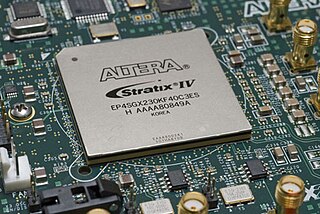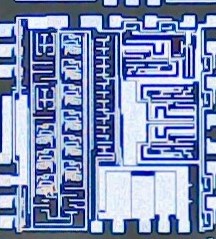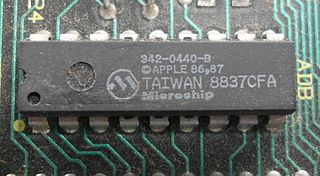Related Research Articles

A field-programmable gate array (FPGA) is an integrated circuit designed to be configured by a customer or a designer after manufacturing – hence the term field-programmable. The FPGA configuration is generally specified using a hardware description language (HDL), similar to that used for an application-specific integrated circuit (ASIC). Circuit diagrams were previously used to specify the configuration, but this is increasingly rare due to the advent of electronic design automation tools.

Moore's law is the observation that the number of transistors in a dense integrated circuit (IC) doubles about every two years. Moore's law is an observation and projection of a historical trend. Rather than a law of physics, it is an empirical relationship linked to gains from experience in production.

Complementary metal–oxide–semiconductor is a type of metal–oxide–semiconductor field-effect transistor (MOSFET) fabrication process that uses complementary and symmetrical pairs of p-type and n-type MOSFETs for logic functions. CMOS technology is used for constructing integrated circuit (IC) chips, including microprocessors, microcontrollers, memory chips, and other digital logic circuits. CMOS technology is also used for analog circuits such as image sensors, data converters, RF circuits, and highly integrated transceivers for many types of communication.
Atmel Corporation was a creator and manufacturer of semiconductors before being subsumed by Microchip Technology in 2016. Atmel was founded in 1984. The company focused on embedded systems built around microcontrollers. Its products included microcontrollers radio-frequency (RF) devices including Wi-Fi, EEPROM, and flash memory devices, symmetric and asymmetric security chips, touch sensors and controllers, and application-specific products. Atmel supplies its devices as standard products, application-specific integrated circuits (ASICs), or application-specific standard product (ASSPs) depending on the requirements of its customers.
SiGe, or silicon–germanium, is an alloy with any molar ratio of silicon and germanium, i.e. with a molecular formula of the form Si1−xGex. It is commonly used as a semiconductor material in integrated circuits (ICs) for heterojunction bipolar transistors or as a strain-inducing layer for CMOS transistors. IBM introduced the technology into mainstream manufacturing in 1989. This relatively new technology offers opportunities in mixed-signal circuit and analog circuit IC design and manufacture. SiGe is also used as a thermoelectric material for high-temperature applications (>700 K).
In electronics, rapid single flux quantum (RSFQ) is a digital electronic device that uses superconducting devices, namely Josephson junctions, to process digital signals. In RSFQ logic, information is stored in the form of magnetic flux quanta and transferred in the form of Single Flux Quantum (SFQ) voltage pulses. RSFQ is one family of superconducting or SFQ logic. Others include Reciprocal Quantum Logic (RQL), ERSFQ – energy-efficient RSFQ version that does not use bias resistors, etc. Josephson junctions are the active elements for RSFQ electronics, just as transistors are the active elements for semiconductor electronics. RSFQ is a classical digital, not quantum computing, technology.

A mixed-signal integrated circuit is any integrated circuit that has both analog circuits and digital circuits on a single semiconductor die. Their usage has grown dramatically with the increased use of cell phones, telecommunications, portable electronics, and automobiles with electronics and digital sensors.

ASML Holding N.V. is a Dutch multinational corporation founded in 1984. ASML specializes in the development and manufacturing of photolithography machines which are used to produce computer chips. As of 2022 it is the largest supplier for the semiconductor industry and the sole supplier in the world of extreme ultraviolet lithography (EUV) photolithography machines used to manufacture the most advanced chips. As of 2022, ASML was the most highly valued European tech company by market capitalization with about $200 billion.

A network on a chip or network-on-chip is a network-based communications subsystem on an integrated circuit ("microchip"), most typically between modules in a system on a chip (SoC). The modules on the IC are typically semiconductor IP cores schematizing various functions of the computer system, and are designed to be modular in the sense of network science. The network on chip is a router-based packet switching network between SoC modules.
The 32 nm node is the step following the 45 nm process in CMOS (MOSFET) semiconductor device fabrication. "32-nanometre" refers to the average half-pitch of a memory cell at this technology level. Toshiba produced commercial 32 GiB NAND flash memory chips with the 32 nm process in 2009. Intel and AMD produced commercial microchips using the 32-nanometre process in the early 2010s. IBM and the Common Platform also developed a 32 nm high-κ metal gate process. Intel began selling its first 32 nm processors using the Westmere architecture on 7 January 2010.
Soitec is an international company, based in France, that manufactures high performance substrates used in the manufacture of semiconductors.

Microchip Technology Inc. is a publicly-listed American corporation that manufactures microcontroller, mixed-signal, analog and Flash-IP integrated circuits. Its products include microcontrollers, Serial EEPROM devices, Serial SRAM devices, embedded security devices, radio frequency (RF) devices, thermal, power and battery management analog devices, as well as linear, interface and wireless products.
Hyper-encryption is a form of encryption invented by Michael O. Rabin which uses a high-bandwidth source of public random bits, together with a secret key that is shared by only the sender and recipient(s) of the message. It uses the assumptions of Ueli Maurer's bounded-storage model as the basis of its secrecy. Although everyone can see the data, decryption by adversaries without the secret key is still not feasible, because of the space limitations of storing enough data to mount an attack against the system.
The random neural network (RNN) is a mathematical representation of an interconnected network of neurons or cells which exchange spiking signals. It was invented by Erol Gelenbe and is linked to the G-network model of queueing networks as well as to Gene Regulatory Network models. Each cell state is represented by an integer whose value rises when the cell receives an excitatory spike and drops when it receives an inhibitory spike. The spikes can originate outside the network itself, or they can come from other cells in the networks. Cells whose internal excitatory state has a positive value are allowed to send out spikes of either kind to other cells in the network according to specific cell-dependent spiking rates. The model has a mathematical solution in steady-state which provides the joint probability distribution of the network in terms of the individual probabilities that each cell is excited and able to send out spikes. Computing this solution is based on solving a set of non-linear algebraic equations whose parameters are related to the spiking rates of individual cells and their connectivity to other cells, as well as the arrival rates of spikes from outside the network. The RNN is a recurrent model, i.e. a neural network that is allowed to have complex feedback loops.

A multigate device, multi-gate MOSFET or multi-gate field-effect transistor (MuGFET) refers to a metal–oxide–semiconductor field-effect transistor (MOSFET) that has more than one gate on a single transistor. The multiple gates may be controlled by a single gate electrode, wherein the multiple gate surfaces act electrically as a single gate, or by independent gate electrodes. A multigate device employing independent gate electrodes is sometimes called a multiple-independent-gate field-effect transistor (MIGFET). The most widely used multi-gate devices are the FinFET and the GAAFET, which are non-planar transistors, or 3D transistors.
Krishna V. Palem is a computer scientist and engineer of Indian origin and is the Kenneth and Audrey Kennedy Professor of Computing at Rice University and the director of Institute for Sustainable Nanoelectronics (ISNE) at Nanyang Technological University (NTU). He is recognized for his "pioneering contributions to the algorithmic, compilation, and architectural foundations of embedded computing", as stated in the citation of his 2009 Wallace McDowell Award, the "highest technical award made solely by the IEEE Computer Society".

Random-access memory is a form of computer memory that can be read and changed in any order, typically used to store working data and machine code. A random-access memory device allows data items to be read or written in almost the same amount of time irrespective of the physical location of data inside the memory, in contrast with other direct-access data storage media, where the time required to read and write data items varies significantly depending on their physical locations on the recording medium, due to mechanical limitations such as media rotation speeds and arm movement.
Ali Hajimiri is an academic, entrepreneur, and inventor in various fields of engineering, including electrical engineering and biomedical engineering. He is the Bren Professor of Electrical Engineering and Medical Engineering at the California Institute of Technology (Caltech).
Superconducting logic refers to a class of logic circuits or logic gates that use the unique properties of superconductors, including zero-resistance wires, ultrafast Josephson junction switches, and quantization of magnetic flux (fluxoid). Superconducting computing is a form of cryogenic computing, as superconductive electronic circuits require cooling to cryogenic temperatures for operation, typically below 10 kelvin. Often superconducting computing is applied to quantum computing, with an important application known as superconducting quantum computing.

Beyond CMOS refers to the possible future digital logic technologies beyond the CMOS scaling limits which limits device density and speeds due to heating effects.
References
- ↑ "Scientists develop revolutionary microchip that uses 30 times less energy". Phys.org. 2009.
- ↑ "Revolutionary microchip uses 30 times less power". Rice University. Archived from the original on 2012-02-18.
- ↑ "The top underreported tech stories of 2009". InfoWorld. 28 December 2009.
- ↑ Lakshmi N. Chakrapani; Bilge E. S. Akgul; Suresh Cheemalavagu; Pinar Korkmaz; Krishna V. Palem; Balasubramanian Seshasayee. Ultra Efficient Embedded SOC Architectures based on Probabilistic CMOS (PCMOS) Technology. Design Automation and Test in Europe Conference (DATE), 2006. CiteSeerX 10.1.1.130.7547 . doi:10.1109/DATE.2006.243978. ISBN 3-9810801-1-4.